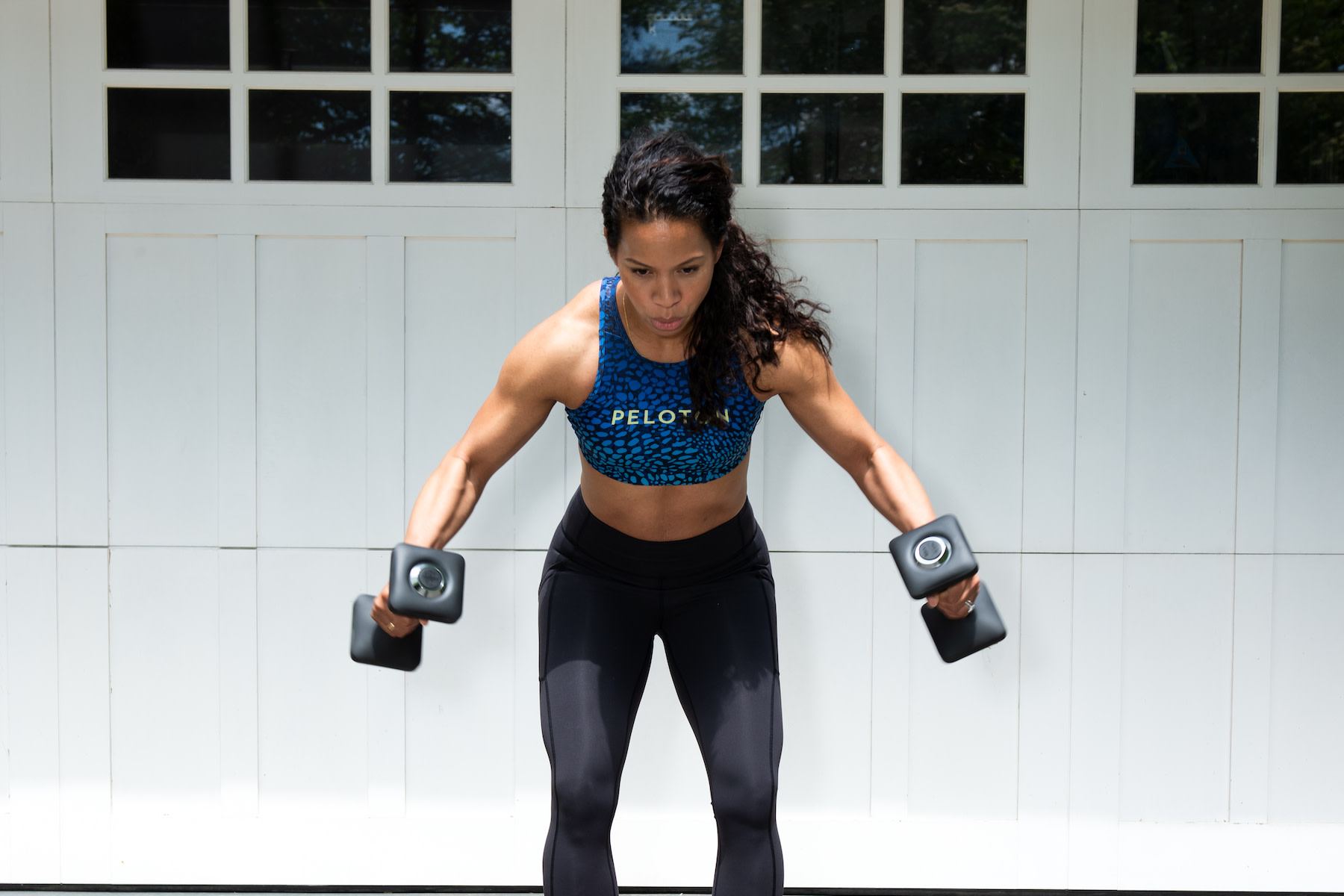
10 Dumbbell Moves for a Strong and Healthy Back
Yes, you should train your back muscles. Here's why.
By Emilia Benton•
Why Should You Train Your Back Muscles?
What Are the Key Muscles in Your Back (And How to Target Them)
The Benefits of Doing Dumbbell Back Exercises
How to Warm Up Your Back Before Training
The Best Dumbbell Back Exercises
Dumbbells are some of the most versatile pieces of equipment you can own in your home gym. When you think of dumbbell workouts, you may primarily associate them with bicep curls, but they can actually be quite beneficial in building another important muscle group: your back.
Discover more ways to reach your goals with Peloton
Working your back muscles is key for a strong core and keeping your posture in check—among other benefits we’ll dive into more below. Plus we’ll break down the muscles that make up the back, why it’s important to train them, and share the best dumbbell back exercises to add to your strength training routine.
Why Should You Train Your Back Muscles?
According to Austin Cagley, Senior Manager of Global Instructor Development at Peloton, building back strength is a crucial aspect of overall health and fitness. To start, a strong back provides a foundation for your entire body, in addition to other benefits, including improving posture and supporting the spine.
“Having good posture prevents pain and discomfort from slouching or hunching while at a keyboard or looking down at your phone all day,” Cagley explains. “Strong back muscles can also reduce the risk of injury by protecting and supporting your spine and core.”
Having a strong back can also enhance performance in sports and other physical activities, as well as everyday tasks like lifting heavy boxes or carrying groceries, Cagley continues. “A strong back can help with stability and balance, also reducing the risk of injury,” he says.
What Are the Key Muscles in Your Back (And How to Target Them)
According to Jaime Aparicio, a physical therapist and sports clinical therapist in Houston, the back has multiple layers of muscles, all of which play important roles in supporting posture, movement, and stability.
“These muscles are important to strengthen to fight some of the poor positions (forward flexed) we adopt in our society on a daily basis, such as sitting, working on computers, driving, and cell phone usage,” says Aparicio.
Some of these key muscle groups are:
Multifidus: These are small, deep muscles that run along the spine and are essential for spinal stability and control. These muscles play a crucial role in preventing and managing back pain, Aparicio says.
Erector spinae: These are deep muscles that run along the spine and help you maintain an upright posture.
Latissimus dorsi: These are large muscles on either side of the back that contribute to shoulder movement and stability.
Trapezius: This is a large muscle that extends from the base of the skull to the middle of the back and between the shoulder blades. “They play a crucial role in preventing neck pain and shoulder dysfunction,” Aparicio says.
Rhomboids: Located between the shoulder blades, the rhomboids retract and stabilize the scapula. “Strengthening these muscles can help address postural issues and shoulder dysfunction,” Aparicio says.
The Benefits of Doing Dumbbell Back Exercises
Working out with dumbbells is beneficial for several reasons, Cagley says. These include:
You Can Train at Home
Many people choose to work out at home for the convenience factor. Dumbbells are relatively inexpensive and take up little space, making them easy to store, Aparicio adds. You can also easily add or reduce weight by alternating different size weights.
You Can Isolate Certain Muscle Groups
Zeroing in on specific muscle groups in the back makes for a more focused training approach that also allows you to target weak spots.
“We can get a bigger range of motion with dumbbells as opposed to machines,” Cagley says. “You can also work through a larger range of motion with dumbbells than you can with a barbell,” Aparicio adds.
You Can Work Unilaterally, or Focus On One Side of the Body
Working out with dumbbells makes it easy to work on one side of the back at a time.
“This is key for working on imbalances and ensuring equal development on both sides of our back,” Cagley says.
“Since your arms are working independently, dumbbells are also great for working stabilizer muscles of both the back and shoulders and avoiding compensation from the opposite side,” Aparicio adds.
They Add Extra Load for Your Muscles to Adapt to
Adding weight to your back exercises is another way to challenge your body more, says Amber Lowe, a physical therapist in Houston.
How to Warm Up Your Back Before Training
Just like with any intense activity, it’s important to warm up your back before beginning dumbbell strength exercises to target it. Cagley recommends doing light cardio to get blood flow through the body to warm up the muscles, along with dynamic stretches such as arm circles, torso twists, and bodyweight squats with a focus on the back muscles to prime your body for movement.
“Make sure that when you add load/more weight, you don’t compromise your form and proper activation in order to say you lifted more, as that is what leads to injury,” Lowe adds.
One thing to consider is adjusting the leverage (how close the weight is to your body) to challenge your body more, she says.
“For example, with a row with your arms close to your body, you can typically do more weight than a reverse fly, where the weight is farther from your body,” she says.
The Best Dumbbell Back Exercises
Cagley also recommends starting with lighter weights and slowly increasing as you build strength and feel ready to challenge yourself further for dumbbell back exercises.
“Start light and slow and choose a weight that you can comfortably do over 10 reps,” he says. “Focus on form first and foremost, and as you get comfortable, slowly work your way up in weight.
Depending on your goals, the number of sets and reps you can do will change, he adds.
Below are 10 expert-recommended dumbbell back exercises to try.
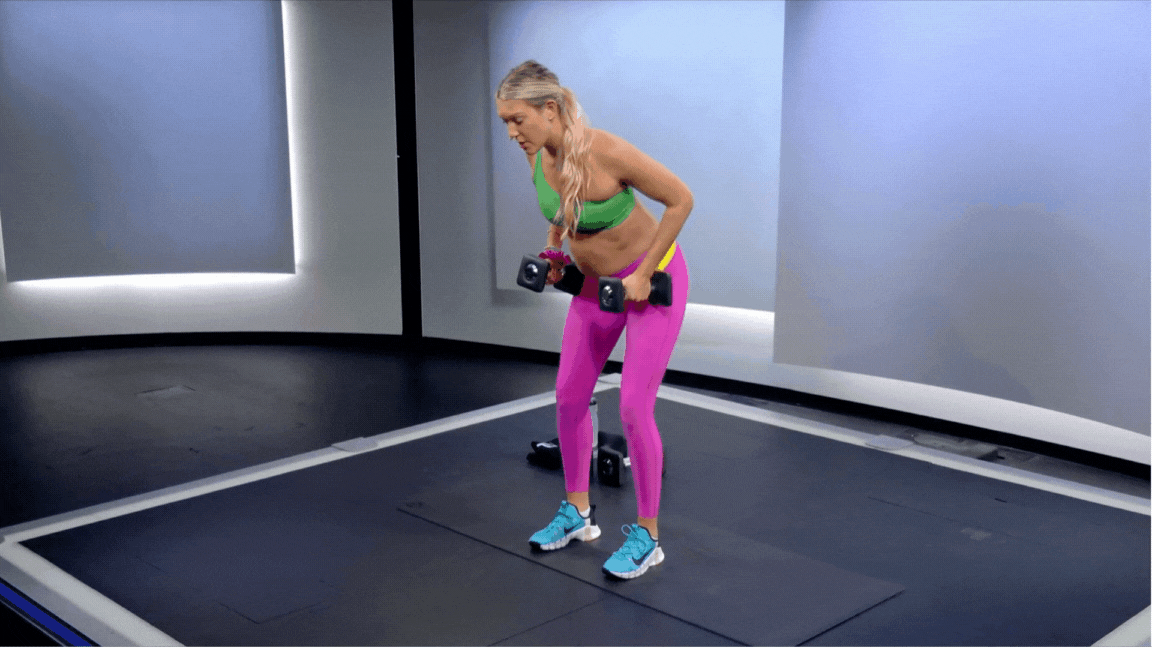
Dumbbell Bent-Over Row
1. Hinge at the hips with a flat back by engaging the latissimus dorsi muscles.
2. Keep your eyes gazing toward the floor, with your palms facing each other for a neutral grip.
3. Pull the weights up toward the body and slowly lower them back to arms extended.
Muscles worked: latissimus dorsi, rhomboids, and trapezius muscles
Superman
1. Lie facedown on the floor with arms out ahead of you.
2. Lift your arms, chest, and legs as high as you can off the floor.
3. Pause for a moment and slowly lower back down to the floor.
4. Repeat for the desired number of reps.
Muscles worked: lower back and trapezius, and also the core and glutes
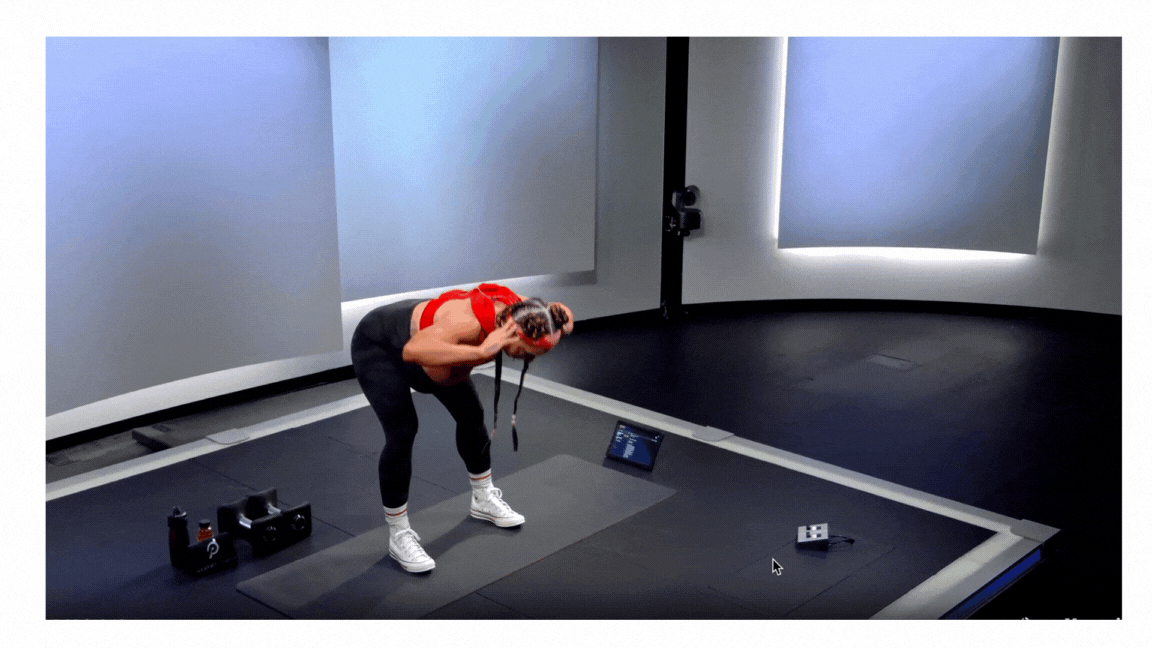
Good Morning
1. Stand with your feet hip-width apart, knees slightly bent, holding a dumbbell in each hand, and resting on top of each shoulder. “Another option is to hold one dumbbell across the chest,” Aparicio says.
2. Keeping your knees slightly bent, push your hips back and your upper body forward until your torso is almost parallel with the floor. “Keep your core engaged, chest up, and spine straight throughout,” Aparicio says.
3. Pause at the bottom of the movement before returning to the starting position by pushing your hips forward. Avoid extending the back to get up.
4. Repeat for the desired number of reps.
Muscles worked: hamstrings, glutes, lower multifidi, and erector spinae
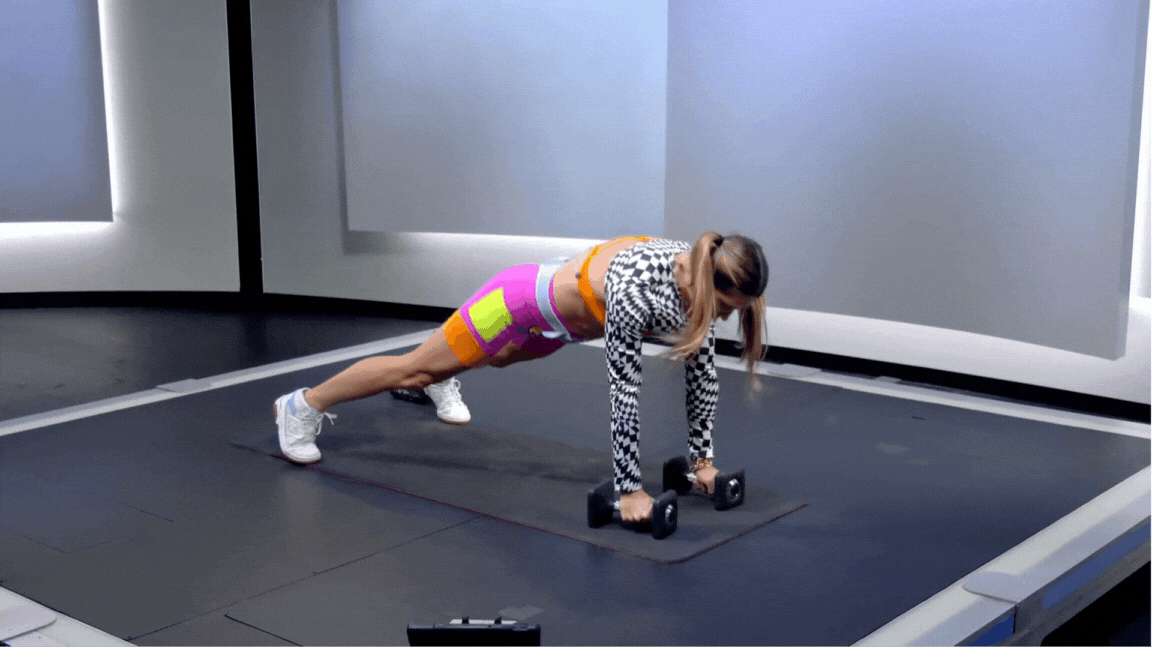
Renegade Row
1. Grab a pair of dumbbells and get into a push-up or plank position.
2. Set your feet to a wide stance to help with stability.
3. Brace your core to stabilize your body as you pull one arm and row with your elbow close to your side and retract your shoulder blade.
4. Prevent any movement at the torso and stabilize the arm on the opposite side.
5. Slowly lower the dumbbell back to the ground and switch sides.
Muscles worked: core, latissimus dorsi, trapezius, rhomboids, multifidi, and erector spinae
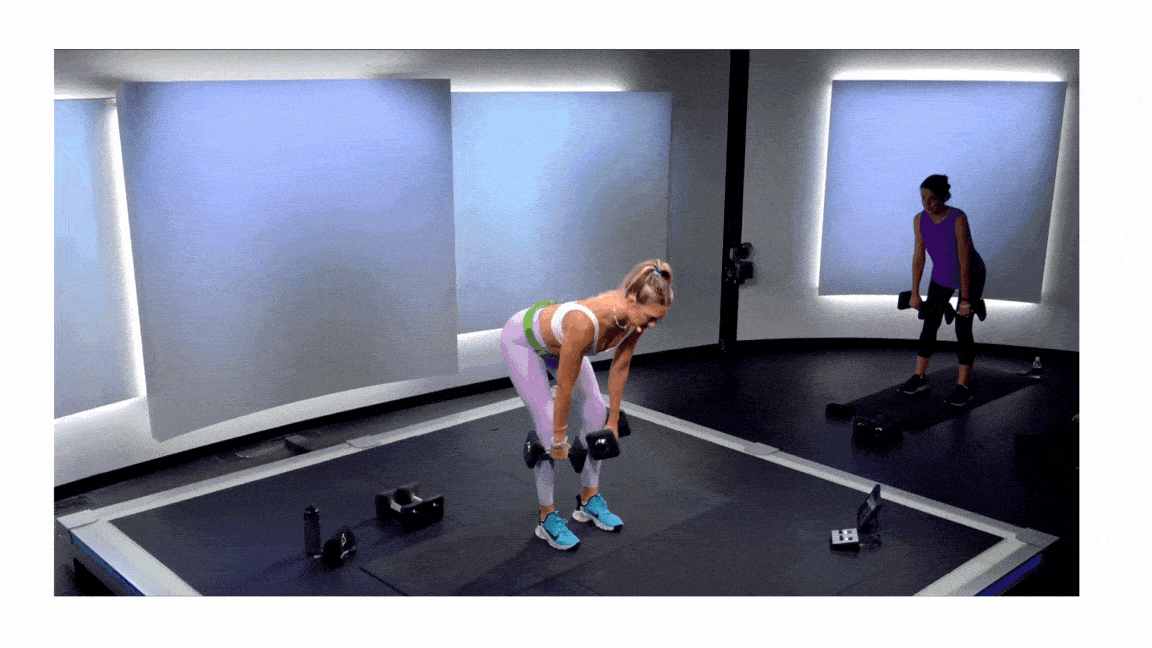
Romanian Deadlift
1. Start standing with your feet hip-width apart, holding a dumbbell in each hand and a slight bend in your knees.
2. Position the dumbbells in front of your thighs, palms facing your body.
3. Begin the movement by hinging at your hips, pushing them backward while keeping your back straight.
4. Slowly lower the dumbbells down the front of your legs as far as your flexibility allows, keeping them close to your body while maintaining a neutral spine throughout the movement. “Avoid rounding or arching your back,” Aparicio says.
5. Pause at the bottom of the movement before returning to the starting position by pushing your hips forward. “Avoid extending the back to get up,” Aparicio says.
Muscles worked: hamstrings, glutes, lower multifidi, and erector spinae
Bird Dog Row
1. Start in a tabletop position on hands and knees with wrists aligned under shoulders and knees under hips.
2. Hold a dumbbell in one hand, keeping it directly under your shoulder, and extend your opposite leg straight behind you.
3. Engage your core to prevent torso rotation as you row the dumbbell toward your hip, retracting your shoulder blade and keeping your elbow close to your body.
4. Maintain the opposite leg straight and core engaged, ensuring a straight line from your head to your heel throughout the movement.
5. Slowly lower the dumbbell and repeat for desired reps before changing the movement to the opposite side.
Muscles worked: core, latissimus dorsi, trapezius, rhomboids, multifidi, and erector spinae
Lat Pull Over
Start with your back on a flat bench and feet planted on the floor.
Hold a dumbbell with both hands, palms gripping one end of the dumbbell, and extend your arms straight above your chest.
Keeping a slight bend in your elbows, lower the dumbbell in a controlled manner backward over your head.
Activate your core musculature to keep your low back in a neutral position and avoid extending at the low back.
Focus on engaging your lat muscles as you feel a stretch in your chest and latissimus dorsi.
Muscles worked: core and latissimus dorsi

Reverse Fly
1. Start standing with a hinge at your hips and a slight bend in the knees with dumbbell arms hanging straight down in front of you.
2. Hold the dumbbells with a neutral grip (palms facing each other) in front of your thighs.
3. Keeping a slight bend in your elbows, lift both dumbbells out to the sides, away from your body.
4. Focus on squeezing your shoulder blades together and keeping your chest lifted.
5. Lift the dumbbells until your arms are parallel to the ground or slightly below shoulder level.
6. Lower the dumbbells back down to the starting position, controlling the descent.
Muscles worked: This exercise targets the trapezius, rhomboids, multifidi, and erector spinae
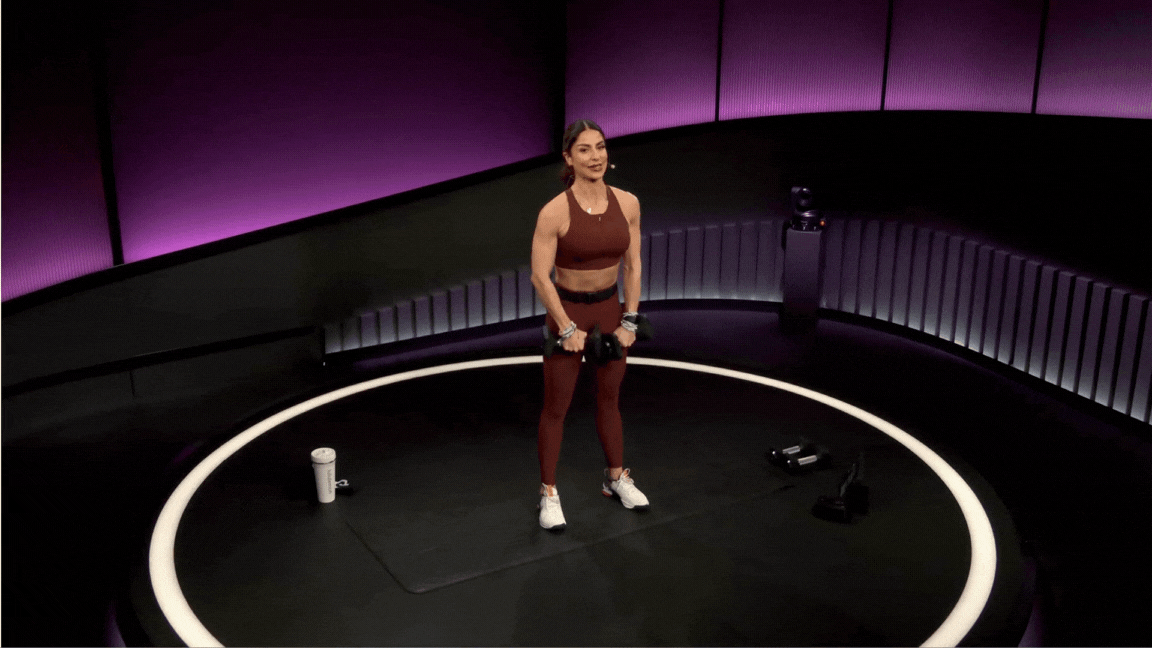
Upright Row
While standing grab a pair of dumbbells with an overhand grip with your palms facing toward you.
Roll your shoulders back and brace your core to isolate your traps and top of the deltoids.
Bring the dumbbells straight up and close to your body with elbows flared out
Hold, then release back to the starting position.
Muscles worked: This move targets the trapezius and rhomboids
Farmer’s Carry
1. Start standing upright with a dumbbell in each hand, holding them at your side.
2. Ensure your shoulders are pulled back, maintaining a neutral spine.
3. Walk with a steady and controlled gait, maintaining an upright posture.
4. Walk for a predetermined distance or time.
Muscles worked: trapezius, rhomboids, latissimus dorsi, erector spinae, and multifidi
Want more? Try these suggestions from Peloton instructor Rebecca Kennedy.

Peloton App
Access thousands of classes with no equipment needed.
This content is for informational and educational purposes only and does not constitute individualized advice. It is not intended to replace professional medical evaluation, diagnosis, or treatment. Seek the advice of your physician for questions you may have regarding your health or a medical condition. If you are having a medical emergency, call your physician or 911 immediately.
Level up your inbox.
Subscribe for a weekly dose of fitness, plus the latest promos, launches, and events.
By providing your email address, you agree to receive marketing communications from Peloton.
For more about how we use your information, see our Privacy Policy.








